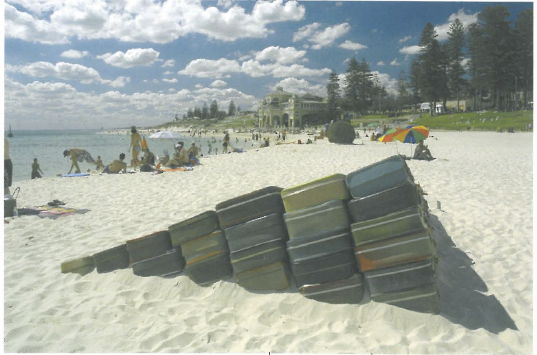
Sculpture by the Sea at Cottesloe Beach in March was a very successful exhibition. It caught the attention of the general public and was well attended, and there was a good cross-section of contemporary Australian and international sculpture.
Cottesloe is one of the most popular and accessible family beaches in Perth, surrounded by expensive real estate but used by people from throughout the metropolitan area, so the exhibition had the advantage of being egalitarian yet close to the people with big purchasing power.
I attended with a group of friends, one of whom was aged six, so imagine our dismay when we saw the 'keep off' signs. It doesn't make for a pleasant experience for anyone if you have to keep yelling 'DON'T TOUCH, GET OFF'. The place was crawling with kids, many of them on the luxuriant red caged dinosaur by Chinese artist Sui Jianguo. And touching was not confined to children - I saw quite a few adults patting the heads of the 'little women' in Richie Kuhaupt's installation Layers on Layers. But this physical contact was made with an affection that should be appreciated, rather than discouraged. 'Please be gentle with the artworks, touch carefully' might be a better sign.
One of the big strengths of the exhibition was the diversity of work from international and national artists, as well as those from Western Australia. The general public got a pretty good overview of contemporary sculpture and there was something in the exhibition for everyone. While I stood in front of Ben Juniper's very illustrative Bee Complex, thinking that for all its beautiful craftsmanship it was a bit too literal, others were in raptures over it.
The methodology for selecting WA artists was a bit odd. The curatorial panel selected ten sculptors to exhibit, who then nominated another two sculptors each. This system meant that a number of very significant Western Australian sculptors were not represented or even invited - although on the other hand, some little-known artists did get an opportunity to show their work.
Irrespective of personal taste, across the thirty-eight works there were a couple that just didn't cut it. Virginia Ward's Hoop and Rod may have looked arresting in a minimalist white gallery, but was totally lost on the beach.
It was a joy to see the elegant sculptures by Japanese artists Keizo Ushio and Yoshio Nitta. Ushio's carefully carved granite work Oushi Zokei was exquisitely proportioned and resolved. Nitta's assemblage Four Pots was a perfect harmony of copper, stainless steel, stone and resin, through which he encouraged us to look up at the blue sky. Likewise Negative Ions by WA artist Louise Elscot - small chrome balls waving on steel stems - reflected and drew attention to the surroundings, as did Lorenna Grant's prize-winning Furball, a giant globe of wire and seaweed with a delicate yet commanding presence on the shoreline.
In contrast, Susan Flavell's giant Crabbed was at first glance crude and clumsily modelled. Flavell is a disconcerting artist who often inhabits a world of the kind of make-believe creatures that can be disturbingly creepy. She turns our preconceptions about how materials should be used upside down. The power of Flavell's work lies in the questions she provokes and how those questions linger, long after the exhibition.
A beach is not only a place of leisure. Nein Schwarz's installation Transpose transpose used old suitcases embedded in the sand to acknowledge the waves of migrants who arrived by boat, either by choice or necessity.
Still, recreation is a good thing. Sitting on the grass bank looking at and through Kevin Draper's beautifully sited metal tree, Boundary, framed by pine trees against a backdrop of sea and sky, summed up all that was good about being on a magnificent beach in Perth on a balmy evening at the end of summer.












